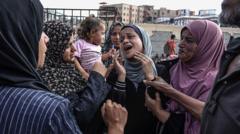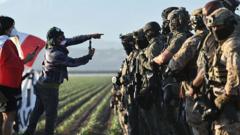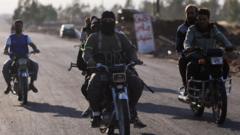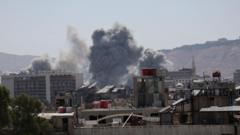The health authorities in Gaza reported that Israeli military operations claimed the lives of at least 32 individuals on Saturday near a food distribution site. This incident adds to the already alarming toll of over 670 Palestinians reported killed since the implementation of a controversial food aid system by Israel two months ago.
Gaza Death Toll Rises Amid Ongoing Aid Distribution Conflict

Gaza Death Toll Rises Amid Ongoing Aid Distribution Conflict
Israeli military actions near food distribution sites in Gaza have resulted in significant civilian casualties, sparking outrage and raising urgent humanitarian concerns.
The Gaza Health Ministry claimed that the casualties were primarily from civilians trying to access aid during a period marked by increasing violence. Eyewitness accounts and Palestinian news outlets relayed that Israeli troops reportedly opened fire on individuals gathered for food distribution organized by the Gaza Humanitarian Foundation, an Israel-backed entity that has replaced the United Nations' previous aid distribution framework. The Nasser Medical Complex in southern Gaza confirmed receipt of 29 bodies but did not clarify their origins or circumstances of death.
This new system of food distribution, initiated in late May, has faced significant criticism. While Israeli officials claim it helps prevent Hamas from misappropriating and selling aid, humanitarian organizations argue it has exacerbated risks, turning food-seeking missions into life-threatening endeavors. Reports detail how crowds of desperate civilians have been regularly confronted by Israeli soldiers, who have acknowledged using lethal force as a measure of crowd control at these aid sites.
Recent analyses from the United Nations further highlight the dire state of food security in Gaza, showing that malnutrition rates have surged, especially among children. In June alone, UNRWA reported screening over 10,600 children, identifying nearly one in ten as suffering from malnourishment. Critics urge that the implementation of the new aid model has not succeeded in effectively addressing rampant hunger, especially following the extensive blockade that restricted food and fuel supplies from March to May.
The ongoing situation remains precarious, as the violence and humanitarian crisis persist against a backdrop of conflicting narratives from the Israeli government and Palestinian authorities.
Ameera Harouda contributed to this report.
This new system of food distribution, initiated in late May, has faced significant criticism. While Israeli officials claim it helps prevent Hamas from misappropriating and selling aid, humanitarian organizations argue it has exacerbated risks, turning food-seeking missions into life-threatening endeavors. Reports detail how crowds of desperate civilians have been regularly confronted by Israeli soldiers, who have acknowledged using lethal force as a measure of crowd control at these aid sites.
Recent analyses from the United Nations further highlight the dire state of food security in Gaza, showing that malnutrition rates have surged, especially among children. In June alone, UNRWA reported screening over 10,600 children, identifying nearly one in ten as suffering from malnourishment. Critics urge that the implementation of the new aid model has not succeeded in effectively addressing rampant hunger, especially following the extensive blockade that restricted food and fuel supplies from March to May.
The ongoing situation remains precarious, as the violence and humanitarian crisis persist against a backdrop of conflicting narratives from the Israeli government and Palestinian authorities.
Ameera Harouda contributed to this report.





















